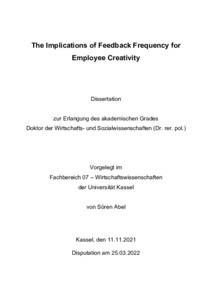Datum
2022Autor
Abel, SörenSchlagwort
300 Sozialwissenschaften, Soziologie 330 Wirtschaft UnternehmenArbeitnehmerInnerbetriebliche KommunikationRückmeldungHäufigkeitKreativitätMetadata
Zur Langanzeige
Dissertation

The Implications of Feedback Frequency for Employee Creativity
Zusammenfassung
Managers are still floundering when they have to decide on the optimal level of feedback frequency; either when they consider themselves as a source of feedback, but also when they shape the feedback environment of their employees, e.g., by allowing more (or less) frequent customer feedback. Furthermore, given that feedback is a time-consuming task, managers might be reluctant to provide feedback frequently, foregoing a potentially powerful lever for increasing employee creativity. Ultimately, clarifying the ambiguities about the implications of feedback frequency on employee creativity is essential since feedback frequency is an inevitable managerial decision – even no feedback has a frequency. Consequently, a major goal of this dissertation is to fill this research gap and examine the effects of feedback frequency on employee creativity. In doing so, I make important contributions to various streams of literature, such as management control system research, the feedback literature, service research, and gender research. As an empirical basis, three distinct studies are conducted, two surveys (n = 385; n = 400) and one field experiment (n = 105), and the data is analyzed with state-of-the-art procedures, e.g., PLS-POS, FIMIX-PLS, or high-creativity idea identification (cf. Hair et al. 2016; Kachelmeier, Wang, and Williamson 2019; Matthews et al. 2016). Indeed, my results reveal that the frequency of feedback is a powerful lever for managers to enhance employee creativity. However, the findings underline the imperative of a thoughtful decision about the frequency of the provided feedback. Furthermore, I discuss how these insights can be exploited by managers to design superior feedback strategies.
Zitieren
@phdthesis{doi:10.17170/kobra-202205136174,
author={Abel, Sören},
title={The Implications of Feedback Frequency for Employee Creativity},
school={Kassel, Universität Kassel, Fachbereich Wirtschaftswissenschaften},
year={2022}
}
0500 Oax
0501 Text $btxt$2rdacontent
0502 Computermedien $bc$2rdacarrier
1100 2022$n2022
1500 1/eng
2050 ##0##http://hdl.handle.net/123456789/13843
3000 Abel, Sören
4000 The Implications of Feedback Frequency for Employee Creativity / Abel, Sören
4030
4060 Online-Ressource
4085 ##0##=u http://nbn-resolving.de/http://hdl.handle.net/123456789/13843=x R
4204 \$dDissertation
4170
5550 {{Unternehmen}}
5550 {{Arbeitnehmer}}
5550 {{Innerbetriebliche Kommunikation}}
5550 {{Rückmeldung}}
5550 {{Häufigkeit}}
5550 {{Kreativität}}
7136 ##0##http://hdl.handle.net/123456789/13843
<resource xsi:schemaLocation="http://datacite.org/schema/kernel-2.2 http://schema.datacite.org/meta/kernel-2.2/metadata.xsd"> 2022-05-18T15:46:31Z 2022 doi:10.17170/kobra-202205136174 http://hdl.handle.net/123456789/13843 eng Urheberrechtlich geschützt https://rightsstatements.org/page/InC/1.0/ 300 330 The Implications of Feedback Frequency for Employee Creativity Dissertation Managers are still floundering when they have to decide on the optimal level of feedback frequency; either when they consider themselves as a source of feedback, but also when they shape the feedback environment of their employees, e.g., by allowing more (or less) frequent customer feedback. Furthermore, given that feedback is a time-consuming task, managers might be reluctant to provide feedback frequently, foregoing a potentially powerful lever for increasing employee creativity. Ultimately, clarifying the ambiguities about the implications of feedback frequency on employee creativity is essential since feedback frequency is an inevitable managerial decision – even no feedback has a frequency. Consequently, a major goal of this dissertation is to fill this research gap and examine the effects of feedback frequency on employee creativity. In doing so, I make important contributions to various streams of literature, such as management control system research, the feedback literature, service research, and gender research. As an empirical basis, three distinct studies are conducted, two surveys (n = 385; n = 400) and one field experiment (n = 105), and the data is analyzed with state-of-the-art procedures, e.g., PLS-POS, FIMIX-PLS, or high-creativity idea identification (cf. Hair et al. 2016; Kachelmeier, Wang, and Williamson 2019; Matthews et al. 2016). Indeed, my results reveal that the frequency of feedback is a powerful lever for managers to enhance employee creativity. However, the findings underline the imperative of a thoughtful decision about the frequency of the provided feedback. Furthermore, I discuss how these insights can be exploited by managers to design superior feedback strategies. open access Abel, Sören 2022-03-25 VII, 320 Seiten Kassel, Universität Kassel, Fachbereich Wirtschaftswissenschaften Nevries, Pascal (Prof. Dr.) Unternehmen Arbeitnehmer Innerbetriebliche Kommunikation Rückmeldung Häufigkeit Kreativität publishedVersion 2024-03-25 2024-03-25 false true </resource>
Die folgenden Lizenzbestimmungen sind mit dieser Ressource verbunden:
Urheberrechtlich geschützt

